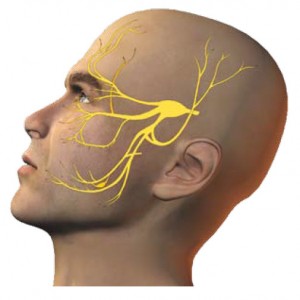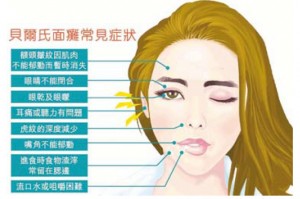
When Mr. Wang was freshening up in the morning, he suddenly found that the corners of his mouth muscles were out of control, and saliva would flow down from the corners of his mouth involuntarily. When he saw his facial expressions in the mirror was asymmetry, he was frightened and thought he had a stroke!

After Mr. Wang’s condition was diagnosed by a neurosurgeon and a MRI, it was discovered that the seventh nerve at the base of the skull was accountable for facial paralysis and cause the paralysis of the facial muscles. The sudden “face and mouth slanted" is indeed worrying.The facial nerve refers to the seventh pair of the 12 pairs of cranial nerves at the base of the skull. When the facial nerve itself or its upper neurons, including the brain stem, facial motor area of the cerebral cortex, or any other related nerve are damaged, facial nerve palsy may occur, symptoms of facial paralysis.
Stroke induces central facial paralysis and facial paralysis
Cerebral stroke does also cause facial palsy, one of which is called “central type" facial palsy, because stroke damages the brain in the cerebral cortex or brainstem, or any other related nerve and is unable to control the facial nerve. However, the symptoms of stroke patients are less limited to the facial nerve and are usually accompanied by other local neurological symptoms, including weakness of the ipsilateral or contralateral hands and feet, numbness, swallowing or speech disorders, etc., and the patients themselves usually cause cardiovascular and cerebrovascular diseases Risk factors as high blood pressure, diabetes, high cholesterol, atrial fibrillation, irregular heart rhythm, etc. In addition, central facial nerve facial palsy and facial palsy refer to damage to the nerves located above the facial nerve nucleus of the brainstem. The patient’s symptoms are mainly paralysis and paralysis of the lower half of the opposite side of the face, but the prefrontal muscles are usually able to move, which is less affected.

Peripheral facial paralysis, facial paralysis
The other is the “peripheral" facial paralysis. Peripheral type Bell’s Palsy is the most common type. It is the seventh skull base nerve line below the brain stem meridian, which paralyzes the ipsilateral meridian. Therefore, clinically, the entire face on the same side is often completely paralyzed. Facial movements, the most common of which is “idiopathic facial nerve palsy", also known as “Bell’s Palsy". According to statistics, there are about 1,000 to 3,000 cases among 7 million people in Hong Kong each year.
Within five days, the unilateral nerves are temporarily paralyzed and the degree of facial paralysis will reach its peak, the face will feel numb or stiff, and the eyelids will appear to dry because they cannot be closed, and there will also be decreased or altered taste.
Viral infection damages nerves
Although the description of Bell’s palsy has a history of more than 150 years, the cause of the disease is still inconclusive. The most frequently mentioned virus infection causes nerve damage, and herpes virus, Epstein-Barr virus, etc. are the most relevant In addition, some scholars believe that it is caused by autoimmune disorders.
Patients with viral infections, poor immunity or diabetes do have a higher clinical risk. Although peripheral facial palsy seems to be difficult to prevent, and the symptoms of crooked face and slanted mouth are scary, it recovers better. About 80 to 85% of patients can fully recover if they can take medicine in the first few days. Only about 10% of patients, especially those who are delayed in seeking medical treatment and taking medication, may have permanent damage or incomplete recovery.
Generally, patients with facial nerve palsy will take high-dose oral steroids for seven days or more to reduce inflammation at the beginning of the onset. There is still debate about whether to use antiviral drugs. Some reports indicate that the use of antiviral drugs will recover faster, but most patients even without medication, it can be cured by the body’s self-repair, the speed of improvement varies from person to person, and usually starts to get better two weeks after the onset of illness, and the recovery period may take one or two months or even longer.

Improve immunity to prevent viruses attack
Many patients will seek alternative therapies such as electrotherapy and acupuncture, but there is currently no evidence that this method will definitely improve quickly. However, there is an alternative therapy that is necessary, that is, using artificial tears or wearing eye masks to avoid exposure to keratitis and blindness, because the eyes are often not completely closed when the facial nerve is palsy, and the eyes cannot be blinked to make tears, except for artificial tears, it is recommended that you wear goggles when you go out, and stick your eyelids with adhesive tape or apply moisturizing eye ointment when you sleep to prevent the cornea from being exposed to dryness and inflammation.
In addition to strokes and viral infections, brain tumors can also cause facial nerve paralysis, which can lead to facial paralysis. Therefore, the focus of treatment for all patients with facial paralysis is to find the cause of the disease.
Although there is no good way to prevent Bell’s palsy, virus infection is the most common known cause, so it is recommended that you work and rest regularly, sleep adequately, pay attention to a healthy diet.

 Book an Appointment
Book an Appointment


